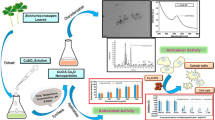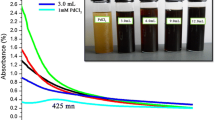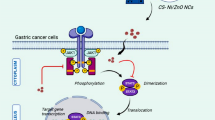Abstract
Palladium (Pd) and zinc oxide (ZnO) (Pd/ZnO NPs) bimettalic nanocomposites still lag much too far behind other nanoparticles investigated for various biological uses in the area of cancer treatments. Chemically created nanoparticles agglomerate under physiological conditions, impeding their use in biomedical applications. In this study, a straightforward and environmentally friendly method for creating bimetallic nanoparticles (NPs) by combining palladium (Pd) and zinc oxide (ZnO) using Crocus sativus extract (CS-Pd/ZnO NCs) was reported; the bio-synthesize bimetallic palladium/zinc oxide nanocomposites and their antioxidant and anti-cancer properties were assessed. The developed Pd/ZnO NPs were characterized using different approaches, including UV-vis, DLS, FTIR, EDX, and SEM analyses. The present investigation shows how nanocomposites are made, their distinctive properties, antioxidant activity, anticancer mechanisms, and their potential therapeutic applications. DPPH and ABTS tests were used to investigate antioxidant activity. Further, the effects of CS-Pd/ZnO NCs on HeLa cells were assessed using the cell viability, ROS generation, MMP levels, and induced apoptosis. Apoptosis induction was measured using an Annexin V-fluorescein isothicyanate assay. Cell DNA was stained with propidium iodide to evaluate the impact upon this cell cycle. Time-dependent cell death was carried on by CS-Pd/ZnO NCs. The maximum inhibitory effect was 59 ± 3.2 when dosages of 4.5 µg/mL or higher were delivered after 24 h of treatment. Additionally, the CS-Pd/ZnO NCs caused HeLa cells to undergo apoptosis. Apoptotic HeLa cells were present in 35.64% of the treated cells at 4.5 µg/mL, and the cell cycle arrest at G0/G1 phase occurred concurrently. According to these findings, the CS-Pd/ZnO NCs may be a promising candidate for the creation of brand-new cervical cancer treatment.












Similar content being viewed by others
Data Availability
Not applicable.
References
Anjum, S., Hashim, M., Malik, S. A., Khan, M., Lorenzo, J. M., Abbasi, B. H., & Hano, C. (2021). Recent advances in zinc oxide nanoparticles (ZnO NPs) for cancer diagnosis, target drug delivery, and treatment. Cancers, 13, 4570.
Bray, F., Ferlay, J., Soerjomataram, I., Siegel, R. L., Torre, L. A., & Jemal, A. (2021). Global cancer statistics 2018: GLOBOCAN estimates of incidence and mortality worldwide for 36 cancers in 185 countries. Cancer Journal for Clinicians, 68, 394–424.
Sung, H., Ferlay, J., Siegel, R. L., Laversanne, M., Soerjomataram, I., Jemal, A., & Bray, F. (2021). Global cancer statistics 2020: GLO-BOCAN estimates of incidence and mortality worldwide for 36 cancers in 185 countries. Cancer Journal for Clinicians, 71, 209–249.
Zhou, Z. W., Long, H. Z., Xu, S. G., Li, F. J., Cheng, Y., Luo, H. Y., & Gao, L. C. (2022). Therapeutic effects of natural products on cervical cancer: Based on inflammatory pathways. Frontiers in Pharmacology, 13, 899208.
Golais, F., & Mrázová, V. (2020). Human alpha and beta herpesviruses and cancer: Passengers or foes? Folia Microbiologia (Praha), 65, 439–449.
Sudomová, M., Berchová-Bímová, K., Marzocco, S., Liskova, A., Kubatka, P., & Hassan, S. T. S. (2021). Berberine in human oncogenic herpesvirus infections and their linked cancers. Viruses, 13(2021), 1014.
Kamran, S., Sinniah, A., Abdulghani, M. A. M., & Alshawsh, M. A. (2022). Therapeutic potential of certain terpenoids as anticancer agents: A scoping review. Cancers (Basel), 14, 1100.
Bijoy, M., Halima, K., Firoz, A., Nasim, A., Hurey, J. K., Uddin, Z., Barun, M. R., Mahmuda, K. S., Syed, H., Rowshanul, R. K., Ahasanur, H. M., & Rabbi, M. (2023). Biosynthesis of Bixa orellana seed extract mediated silver nanoparticles with moderate antioxidant, antibacterial and antiproliferative activity. Arabian Journal of Chemistry, 16, 104675.
Behboodi, S., Baghbani-Arani, F., Abdalan, S., & Shandiz, S. (2019). Green engineered biomolecule-capped silver nanoparticles fabricated from Cichorium intybus extract: In vitro assessment on apoptosis properties toward human breast cancer (MCF-7) cells. Biological Trace Element Research, 187, 392–402.
Asnag, G. M., Oraby, A. H., & Abdelghany, A. M. (2019). Green synthesis of gold nanoparticles and its effect on the optical, thermal and electrical properties of carboxymethyl cellulose. Composites Part B: Engineering, 172, 436–446.
Thomas, B., Vithiya, M., & Augustine Arul Prasad, B. S. (2019). T. Antioxidant and photo catalytic activity of aqueous leaf extract mediated green synthesis of silver nanoparticles using passiflora edulis f.flavicarpa. Materials Today: Proceedings, 14, 239–247.
Babaei, Z., Rezaei, B., Pisheh, M. K., & Afshar-Taromi, F. (2020). In situ synthesis of gold/silver nanoparticles and polyaniline as buffer layer in polymer solar cells. Materials Chemistry and Physics, 248, 122879.
Shahanavaj, K., Anees, A., Ansari, A. M., Anis, A. C., Jakeera, B. S., & Azmat, A. K. (2018). Preparation, characterizations and in vitro cytotoxic activity of nickel oxide nanoparticles on HT-29 and SW620 colon cancer cell lines. 2018. https://doi.org/10.1016/j.jtemb.2018.11.003
Menon, S., Jayakodi, S., Yadav, K. K., Somu, P., Isaq, M., Shanmugam, V. K., Chaitanyakumar, A., & Basavegowda, N. (2022). Preparation of paclitaxel-encapsulated bio-functionalized selenium nanoparticles and evaluation of their efficacy against cervical cancer. Molecules, 27, 7290.
Vimala, K., Sundarraj, S., Paulpandi, M., & Kannan, S. (2014). Green synthesized doxorubicin loaded zinc oxide nanoparticles regulates the Bax and Bcl-2 expression in breast and colon carcinoma. Process Biochemistry, 4, 160–172.
Gengan, R., Anand, K., Phulukdaree, A., & Chuturgoon, A. (2013). A549 lung cell line activity of biosynthesized silver nanoparticles using Albizia adianthifolia leaf. Colloids and Surfaces B, 105, 87–91.
Gunti, L., Dass, R. S., & Kalagatur, N. K. (2019). Phytofabrication of selenium nanoparticles from Emblica officinalis fruit extract and exploring its biopotential applications: Antioxidant, antimicrobial, and biocompatibility. Frontiers in Microbiology, 10, 931.
Cao, Y., Dhahad, H. A., El–Shorbagy, M. A., Alijani, H. Q., Zakeri, M., Heydari, A., Bahonar, E., Slouf, M., Khatami, M., Naderifar, M., Iravani, S., Khatami, S., & Dehkord, F. F. (2021). Green synthesis of bimetallic ZnO–CuO nanoparticles and their cytotoxicity properties. Scientifc Reports, 11, 23479.
Hoshyar, R., Khayati, G. R., Poorgholami, M., & Kaykhaii, M. (2016). A novel green one-step synthesis of gold nanoparticles using crocin and their anti-cancer activities. https://doi.org/10.1016/j.jphotobiol.2016.03.056
Mary, T. A., Shanthi, K., Vimala, K., & Kannan, S. (2016). PEG functionalized selenium nanoparticles as a carrier of crocin to achieve anticancer synergism. RSC Advances, 6, 22936.
Hoshyar, R., Bathaie, S. Z., & Sadeghizadeh, M. (2013). Crocin triggers the apoptosis through increasing the Bax/Bcl-2 ratio and caspase activation in human gastric adenocarcinoma, AGS, cells. DNA and Cell Biology, 32, 50–57.
Mushtaq, S. O., Sharma, R., Agrawal, A., Sharma, A., Kumar, S., Awasthi, K., Yadav, C. S., & Awasthi, A. (2022). Green synthesis of ZnO nanoparticles from saffron corm extract and their bactericidal activity. Materials Today: Proceedings, 69, 74–81.
Vimala, K., Maruthupandian, A., Thangaraj, R., & Kannan, S. (2021). Selenium tethered mesoporous silica nanocomposite enhances drug delivering efficiency to target breast cancer. Journal of Cluster Science, 32, 1475–1489.
Meena, D., Vimala, K., & Kannan, S. (2022). Combined delivery of DOX and kaempferol using PEGylated gold nanoparticles to target colon cancer. Journal of Cluster Science, 33, 173–187.
Joharatnam-Hogan, N., Shiu, K. K., & Khan, K. (2020). Challenges in the treatment of gastric cancer in the older patient. Cancer Treatment Reviews, 85, 101980.
Sun, H., Mohan, S. K., Chinnathambi, A., Alahmadi, T. A., Manikandan, V., Rengarajan, T., & Veeraraghavan, V. P. (2021). Green synthesized zinc oxide/neodymium nanocomposites from Avaram Senna flower extract induces apoptosis in gastric cancer AGS cell line through inhibition of the PI3K/AKT/mTOR signaling pathway. Journal of King Saud University – Science, 33(8), 101641.
Kouhbanani, M. A. J., Sadeghipour, Y., Sarani, M., Sefidger, E., Ilkhani, S., & Amani, A. L. (2021). The inhibitory role of synthesized nickel oxide nanoparticles against Hep-G2, MCF-7, and HT-29 cell lines: The inhibitory role of NiO NPs against Hep-G2, MCF-7, and HT-29 cell lines. Green Chemistry Letters and Reviews, 14(3), 443–453.
Rahdar, A., Hajinezhad, B., Sargazi, S., Barani, M., Bilal, M., & Kyzas, G. K. (2021). Deferasirox-loaded pluronic nanomicelles: Synthesis, characterization, in vitro and in vivo studies. Journal of Molecular Liquids, 323, 114605.
Sargazi, S., Hajinezhad, M., Barani, M., Mukhtar, M., Rahdar, A., Baino, F., Karimi, P., & Pandey, S. (2021). F127/cisplatin microemulsions: In vitro, in vivo and computational studies. Applied Sciences, 11(7), 3006.
Sivamaruthi, B. S., et al. (2019). Biogenic synthesis of silver palladium bimetallic nanoparticles from fruit extract of Terminalia chebula—In vitro evaluation of anticancer and antimicrobial activity. Journal of Drug Delivery Science and Technology, 51, 139–151.
Gurgur, E., Oluyamo, S. S., Adetuyi, A. O., Omotunde, O. I., & Okoronkwo, A. E. (2020). Green synthesis of zinc oxide nanoparticles and zinc oxide–silver, zinc oxide–copper nanocomposites using Bridelia ferruginea as biotemplate. SN Applied Sciences, 2, 911.
Cao, Y., et al. (2021). Ceramic magnetic ferrite nanoribbons: Eco-friendly synthesis and their antifungal and parasiticidal activity. Ceramics International, 48, 1–7.
Reshmy, R., et al. (2021). Nanobiocatalysts: Advancements and applications in enzyme technology. Bioresource Technology, 337, 125491.
Alijani, H. Q., et al. (2021). Biosynthesis of spinel nickel ferrite nanowhiskers and their biomedical applications. Scientific Reports, 11(1), 1–7.
Khatami, M., et al. (2018). Waste-grass-mediated green synthesis of silver nanoparticles and evaluation of their anticancer, antifungal and antibacterial activity. Green Chemistry Letters and Reviews, 11(2), 125–134.
Nazari-Vanani, R., et al. (2017). A novel self-nanoemulsifying formulation for sunitinib: Evaluation of anticancer efcacy. Colloids and Surfaces. B, Biointerfaces, 160, 65–72.
Rahdar, A., et al. (2020). Behavioral effects of zinc oxide nanoparticles on the brain of rats. Inorganic Chemistry Communications, 119, 1–14.
Lomelí-Marroquín, D. (2019). Starch-mediated synthesis of mono-and bimetallic silver/gold nanoparticles as antimicrobial and anticancer agents. International Journal of Nanomedicine, 14(2019), 2171.
Ghosh, S., et al. (2015). Novel platinum–palladium bimetallic nanoparticles synthesized by Dioscorea bulbifera: Anticancer and antioxidant activities. International Journal of Nanomedicine, 10, 7477.
Elemike, E. E., et al. (2019). Green synthesis of Ag, Au and Ag-Au bimetallic nanoparticles using Stigmaphyllon ovatum leaf extract and their in vitro anticancer potential. Materials Letters, 243, 148–152.
Shanthi, K., Sreevani, V., Vimala, K., & Kannan, S. (2017). Cytotoxic effect of palladium nanoparticles synthesized from Syzygium aromaticum Aqueous extracts and induction of apoptosis in cervical carcinoma. Proceedings of the National Academy of Sciences, India Section B: Biological Sciences, 2017. https://doi.org/10.1007/s40011-015-0678-7
Thomas, S., Gunasangkaran, G., Arumugam, V. A., & Muthukrishnan, S. (2022). Synthesis and characterization of Zinc Oxide nanoparticles of Solanum nigrum and its anticancer activity via the induction of apoptosis in Cervical Cancer. Biological Trace Element Research, 200, 2684–2697.
Vimala, K., Shanthi, K., Sundarraj, S., & Kannan, S. (2017). Synergistic effect of chemo-photothermal for breast cancer therapy using folic acid (FA) modified zinc oxide nanosheet. 2017. Journal of Colloid and Interface Science, 488, 92–108.
Rajeshkumar, S., et al. (2018). Biosynthesis of zinc oxide nanoparticles using Mangifera indica leaves and evaluation of their antioxidant and cytotoxic properties in lung cancer (A549) cells. Enyzme and Microbial Technology, 117, 91–95.
Kalaiarasi, A., et al. (2018). Copper oxide nanoparticles induce anticancer activity in A549 lung cancer cells by inhibition of histone deacetylase. Biotechnology Letters, 40(2), 249–256.
Tang, Z. H., Chen, X., Wang, Z. Y., Chai, K., Wang, Y. F., Xu, X. H., Wang, X. W., Lu, J. H., Wang, Y. T., Chen, X. P., & Lu, J. J. (2016). Induction of C/EBP homologous proteinmediated apoptosis and autophagy by licochalcone A in non-small cell lung cancer cells. Scientific Reports, 6, 26241.
Mi, Y., Xiao, C., Du, Q., Wu, W., Qi, G., & Liu, X. (2016). Momordin Ic couples apoptosis with autophagy in human hepatoblastoma cancer cells by reactive oxygen species (ROS)-mediated PI3K/Akt and MAPK signaling pathways. Free Radical Biology and Medicine, 90(2016), 230–242.
Wang, Y., Zhang, Y., Guo, Y., Lu, J., Veeraraghavan, V. P., Mohan, S. K., Wang, C., & Yu, X. (2019). Synthesis of zinc oxide nanoparticles from Marsdenia tenacissima inhibits the cell proliferation and induces apoptosis in laryngeal cancer cells (Hep-2). Journal of Photochemistry and Photobiology B, 201, 111624.
Akhtar, M. J., Ahamed, M., Kumar, S., Khan, M. M., Ahmad, J., & Alrokayan, S. A. (2012). Zinc oxide nanoparticles selectively induce apoptosis in human cancer cells through reactive oxygen species. International Journal of Nanomedicine, 7, 845.
Xia, T., Kovochich, M., Liong, M., Madler, L., Gilbert, B., Shi, H., Yeh, J. I., Zink, J. I., & Nel, A. E. (2008). Comparison of the mechanism of toxicity of zinc oxide and cerium oxide nanoparticles based on dissolution and oxidative stress properties. ACS Nano, 2, 2121–2134.
Hussein, B. Y., & Mohammed, A. M. (2021). Green synthesis of ZnO nanoparticles in grape extract: Their application as anti-cancer and anti-bacterial. Materials Today: Proceedings, 42(3), 18–26.
Funding
No fund disclosure.
Author information
Authors and Affiliations
Contributions
Jun Feng: resources, conceptualization, writing—review and editing. Leilei He: Conceptualization, visualization, writing—review and editing. Jin Qing Hui: methodology, visualization, writing—review and editing. Krishnamoorthy Kavithaa: methodology, visualization, writing—review and editing. Zhengzheng Xu: investigation, conceptualization, supervision, writing—original.
Corresponding author
Ethics declarations
Ethical Approval
Not applicable.
Consent to Participate
Not applicable.
Consent for Publication
All authors agreed to publish this paper in this journal.
Conflict of Interest
The authors declare no competing interests.
Additional information
Publisher’s Note
Springer Nature remains neutral with regard to jurisdictional claims in published maps and institutional affiliations.
Rights and permissions
Springer Nature or its licensor (e.g. a society or other partner) holds exclusive rights to this article under a publishing agreement with the author(s) or other rightsholder(s); author self-archiving of the accepted manuscript version of this article is solely governed by the terms of such publishing agreement and applicable law.
About this article
Cite this article
Feng, J., He, L., Hui, J.Q. et al. Synthesis of Bimetallic Palladium/Zinc Oxide Nanocomposites Using Crocus sativus and Its Anticancer Activity via the Induction of Apoptosis in Cervical Cancer. Appl Biochem Biotechnol (2024). https://doi.org/10.1007/s12010-024-04877-8
Accepted:
Published:
DOI: https://doi.org/10.1007/s12010-024-04877-8




